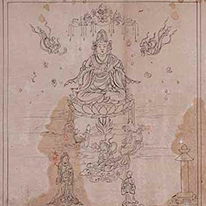Past Exhibitions
- Sacred Representations: Japanese Esoteric Buddhist Iconographic Drawings
- June 13, 2017 - July 23, 2017
The purpose of Esoteric Buddhist iconographic drawings is to communicate the correct ways to portray various deities in paintings or sculptures. While simpler than Buddhist paintings in colors on silk, these monochrome sketches have played an essential role in passing down essential Buddhist imagery over time and geographic space. How did artists make iconographic drawings? First they would coat paper with fast-drying oil (i.e., paulownia or perilla oil) to make it translucent. Next they would lay the paper over another drawing or artwork and trace the image in ink. Most of the oil has washed out during the scroll mounting process, but if you look carefully you may see places where oil resisted ink during the tracing. The quality of a good icongraphic drawing depends upon the skill of the artist. In modern Japan, outstanding drawings were considered as first-rate artworks in their own right, often given lavish mountings and used to decorate the alcoves of tearooms or other important venues.












